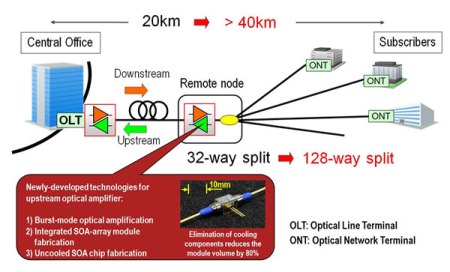Fujitsu and Fujitsu Laboratories have developed a new optical amplifier technology to be utilized in the optical access systems, which connects central offices to the subscribers. This new optical technology enables the splitting number into four times and double the transmission distance.
 Increased splitting number and transmission distance in optical access system using this technology.
Increased splitting number and transmission distance in optical access system using this technology.
The optical aggregation network usage is suggested as one of the means to decrease the regular and growing consumption of electrical power by networking equipment, as the optical signals are transmitted optically between many subscribers and a central office in this aggregation networks.
In order to deal with the limitations of PONs of 10 Gbps, the companies have built a combined semiconductor optical amplifier (SOA) array module fabrication technology, a burst-mode optical amplifier technology along with SOA and an SOA chip fabrication technology that enables uncooled operation.
In the first technology, a single module is fabricated with four semiconductor optical amplifiers that are integrated. This new design of optical coupling pairs four SOAs simultaneously with four high-efficient single mode fibers, which makes it cost-effective.
The second technology is for an amplifier, which senses an arriving upstream burst and changes quickly from the “off” state to the “on” state for optical amplification and switches on the optical amplifier only by an inward upstream burst, while the conventional method will make the ration of optical signal-to-noise to worse.
In the third technology, deployment of aluminum composite in the SOA’s active layer is done to achieve high gain at very high temperatures, which eliminates the SOA’s temperature control, which radically reduces the volume of the module. This SOA chip operates up to 85° C; hence it can be mounted outdoors that allows for distant nodes required to function under harsh circumstances.
These three technologies make it possible for an advanced optical access system to be used as an optical aggregation network with the requirement of low power consumption and at a low cost, which paves the way for cloud infrastructure.
The companies presented the details of these technologies at the 37th European Conference and Exhibition on Optical Communication Conference (ECOC2011), which was held in Geneva from September 18 to 22.